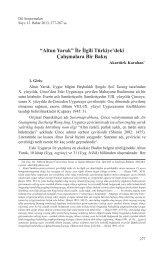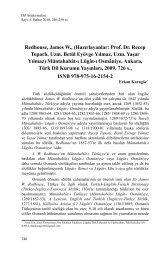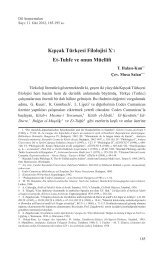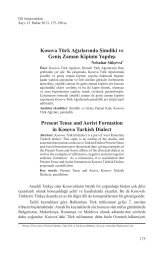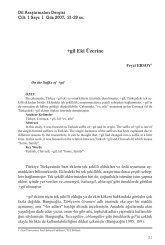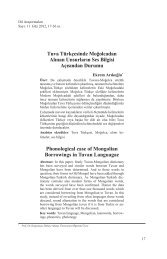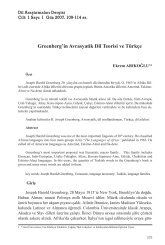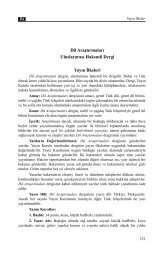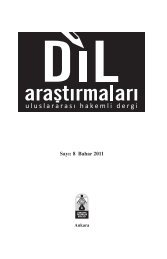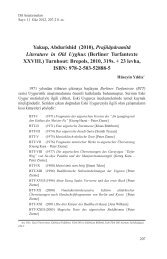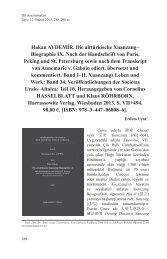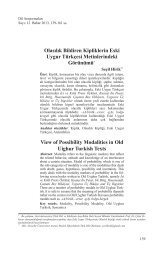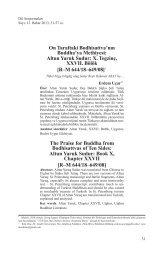Sayı: 10 Bahar 2012 - Dil Arastirmalari
Sayı: 10 Bahar 2012 - Dil Arastirmalari
Sayı: 10 Bahar 2012 - Dil Arastirmalari
Create successful ePaper yourself
Turn your PDF publications into a flip-book with our unique Google optimized e-Paper software.
Editorial Principles<br />
2. Name of the Author: It should be written with the surname in small<br />
letters and bold, under the title and on the right side. Academic position, institution<br />
and e-mail address should be written in italics with an asterisk as a footnote to the<br />
surname at the bottom of the first page.<br />
3. Abstract: The article should include an abstract in Turkish and English<br />
(in maximum <strong>10</strong>0 words) at the beginning of the text. There should be no reference<br />
to sources used, figures and charts etc. There should be key words, maximum ten<br />
words, under the abstract. Abstracts and key words should be written in Turkish and<br />
English.<br />
4. Main Text: The article should be written in MS word program in Times<br />
New Roman, 11 type size and 1 line on A4 format papers. There should be 3 cm<br />
space on the margins and pages should be numbered. Articles should not exceed<br />
<strong>10</strong>000 words. The examples should be in italic, their equivalents in Turkish should<br />
be in quotation marks and not in italic. The articles must confirm to the writing rules<br />
of The Turkish Language Association. If the author had used a special font type, he<br />
should forward it with the article. Besides, the pictures and figures etc. in the article<br />
should be numbered.<br />
5. Indicating Sources and Citations: References within the text should be<br />
given with name and date and/or page in parentheses as follows: (Hacıeminoğlu 1991),<br />
(Hacıeminoğlu 1991: 30). Citations less than 3 lines should be typed between lines and in<br />
quotation marks; citations more than 3 lines should be typed with indent of 1 cm in block, 9<br />
type size and with 1 line space. At which university, for which academic position and when<br />
the cited dissertations are prepared should be stated.<br />
Footnotes should be numbered at the bottom of the page, and be used only for<br />
explanations.<br />
6. References: References should be typed at the end of the text in alphabetical<br />
order of the authors’ surnames, with 9 type size and 1 line space as follows. The names of<br />
the works should be in italic, the names of the articles should be in quotation marks and<br />
other information should be as in the examples. If there are more than one source by the<br />
same author, then they will be listed according to their publication date; sources of the same<br />
author published in the same year will be shown as 2008a, 2008b.<br />
CLAUSON, Sir Gerard (2005), “Altayca Teorisinin Leksikoistatistiksel Bir<br />
Değerlendirmesi” (Çev. İsmail ULUTAŞ) Türk Dünyası İncelemeleri Dergisi V/2,<br />
Kış, Bornova, İzmir, s. 311-324.<br />
ECKMANN, Janos (1988), Çağatayca El Kitabı (çev. Günay KARAAĞAÇ),<br />
İÜEF Yayınları, İstanbul.<br />
ERCİLASUN, Ahmet B. (2007), “Türkçenin En Eski Komşuları” Makaleler<br />
(Haz. Ekrem ARIKOĞLU), Akçağ Yayınları, Ankara, s. 41-62.<br />
KARAHAN, Leyla (1997), “Fiil-Tamlayıcı İlişkisi Üzerine”, Türk <strong>Dil</strong>i, S.<br />
549 (Eylül), Ankara, s. 209-213.<br />
243



